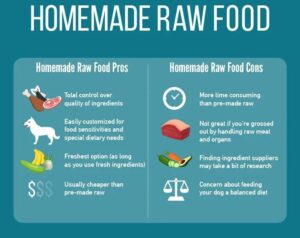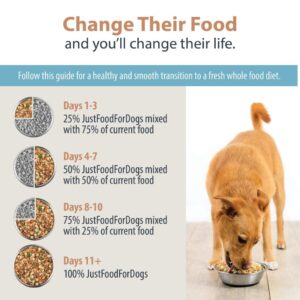As a pet owner, you want the best for your furry friend, and feeding them a balanced and nutritious diet is a top priority. With the rise of the raw dog food trend, many pet owners are wondering if switching to a raw diet is right for their pets. In this article, we’ll explore the pros and cons of raw dog food, its benefits, and risks, and guide how to choose the right one for your dog.
What is Raw Dog Food?
Raw dog food, also known as raw pet food or BARF (Biologically Appropriate Raw Food), is a type of dog food that consists of uncooked ingredients, such as meat, bones, fruits, and vegetables. The diet is designed to mimic the natural diet of wolves and other wild canines, with a focus on providing essential nutrients and eliminating artificial preservatives and additives found in traditional commercial dog foods.
Pros of Raw Dog Food:
- Improved Digestion: Raw dog food is easier to digest, which can lead to fewer digestive issues and less stool production.
- Reduced Allergies: Many dogs experience allergies or sensitivities to commercial dog foods, but switching to a raw diet may help alleviate these symptoms.
- Increased Energy: Raw food is often higher in protein and fat, which can lead to increased energy levels and improved overall health.
- Better Dental Health: Chewing on raw bones can help reduce tartar buildup and promote healthy gums.
- Reduced Shedding: Some owners report a reduction in shedding when switching to a raw diet.
Cons of Raw Dog Food:
- Risk of Bacterial Contamination: Raw meat can contain bacteria like Salmonella and E. coli, which can be transmitted to humans.
- Higher Cost: Raw dog food is often more expensive than traditional commercial dog food.
- Time-Consuming: Preparing raw meals can be time-consuming and labor-intensive.
- Nutrient Imbalance: If not properly balanced, raw dog food can lead to nutrient deficiencies.
- Storage and Handling Concerns: Raw meat requires proper storage and handling to prevent spoilage and contamination.

Benefits of Raw Dog Food:
- Improved Skin and Coat: Many owners report an improvement in their dog’s skin and coat condition after switching to a raw diet.
- Reduced Shedding: Some owners report a reduction in shedding when switching to a raw diet.
- Increased Immune Function: Raw dog food contains natural ingredients that can help support immune function.
- Better Oral Health: Chewing on raw bones can help reduce tartar buildup and promote healthy gums.
- Reduced Allergies: Many dogs experience allergies or sensitivities to commercial dog foods, but switching to a raw diet may help alleviate these symptoms.
Risks of Raw Food:
- Bacterial Contamination: Raw meat can contain bacteria like Salmonella and E. coli, which can be transmitted to humans.
- Nutrient Imbalance: If not properly balanced, raw dog food can lead to nutrient deficiencies.
- Storage and Handling Concerns: Raw meat requires proper storage and handling to prevent spoilage and contamination.
- Higher Cost: Raw dog food is often more expensive than traditional commercial dog food.
- Time-Consuming: Preparing raw meals can be time-consuming and labor-intensive.
How to Choose the Right Raw Food:

- Consult with a Veterinarian: Consult with a veterinarian or canine nutritionist to determine the best raw diet for your dog.
- Choose High-Quality Ingredients: Select ingredients that are fresh, organic, and free-range.
- Look for Balanced Formulas: Ensure the formula is balanced and complete for your dog’s life stage and lifestyle.
- Consider Your Budget: Determine how much you’re willing to spend on raw food.
- Research Brands: Research different brands and read reviews from other pet owners.
Understanding Raw Dog Food Ingredients
When it comes to raw dog food, the ingredients you choose are crucial. A balanced raw diet typically includes:
- Meat: Sources can range from beef, chicken, lamb, turkey, to fish. It’s essential to vary these proteins to provide a range of nutrients.
- Bones: Raw, meaty bones provide calcium and phosphorous, which are essential for bone health. However, cooked bones should never be given, as they can splinter and cause internal injuries.
- Organs: Organ meats like liver, kidney, and heart are nutrient-dense and must comprise about 10-20% of your dog’s diet for optimal health.
- Fruits and Vegetables: While dogs are primarily carnivores, adding some fruits and vegetables can offer additional vitamins, minerals, and antioxidants. Popular choices include carrots, blueberries, and spinach.
- Supplements: Depending on the specific needs of your dog, you may need to add supplements, such as fish oil for omega-3 fatty acids or specific vitamins.
Nutritional Considerations
One of the major challenges of raw dog food diets is ensuring that they are nutritionally balanced. While raw food advocates argue that feeding a raw diet can mimic what dogs would eat in the wild, it can also lead to severe nutritional deficiencies if not adequately formulated.
- Calcium and Phosphorous Ratios: It’s crucial to maintain the right balance of calcium and phosphorous in your dog’s diet. This balance is vital for growing puppies and older dogs to maintain bone health.
- Fat Content: Be cautious about fat content, especially for less active dogs, as weight gain can become a concern.
- Life Stage Appropriateness: Puppies, adult dogs, and senior dogs have different nutritional needs, so tailor your raw dog food choices based on their life stage. Puppy diets, for example, need higher protein levels to support growth.
Potential Health Benefits
Transitioning to a raw dog food diet can yield various health benefits, many of which are anecdotal but supported by some scientific principles:
- Healthier Weight Management: Raw diets tend to be high in protein and low in carbohydrates, which can help dogs maintain a healthy weight. This not only improves general health but can also reduce the risk of diseases like diabetes.
- Better Gastrointestinal Health: Many dogs experience digestive issues when fed kibble or canned food due to fillers and grains. Raw dog food can lead to firmer stools and less frequent bathroom trips.
- Improved Skin and Coat Quality: Owners often notice shinier coats and healthier skin, attributed to the high omega-3 and omega-6 fatty acid content found in raw diets.
- Enhanced Energy Levels: Many owners report that their dogs seem more lively and energetic after switching to a raw dog food diet.
Potential Health Risks
Despite the potential benefits, there are significant risks associated with feeding raw dog food:
- Bacterial Infections: Raw meat can harbor pathogens, such as Salmonella and Listeria. In addition to risking your dog’s health, there is also a concern for humans sharing a household with raw-fed pets. Always practice safe food handling procedures.
- Nutritional Deficiencies: Without proper knowledge or vet guidance, it’s easy to create an unbalanced diet. For example, excessive liver in a diet can lead to vitamin A toxicity.
- Choking Hazards: Raw bones can sometimes pose a choking hazard or cause intestinal blockages if not properly monitored. Always supervise your dog when feeding bones.
- Increased Veterinary Costs: If your dog suffers from health issues stemming from a raw diet, veterinary bills can accumulate rapidly.
Transitioning to Raw Dog Food

If you’ve decided to make the leap to raw dog food, transition your dog gradually. A sudden switch can lead to digestive upset. Here are some recommendations for a smooth transition:
- Start Slow: Begin by mixing a small portion of raw dog food with your dog’s current food. Gradually increase the raw food portion over 7 to 10 days while decreasing the kibble.
- Observe Your Dog: Watch for any signs of digestive upset, such as diarrhea or vomiting. If these occur, slow down the transition or consult your veterinarian.
- Stay Consistent: Once your dog is fully transitioned, stick to a consistent feeding schedule. This helps your dog adapt to their new diet and aids in digestion.
Conclusion: Is Raw Dog Food Right for Your Pet?
The decision to feed your dog a raw diet should not be taken lightly. While many dog owners and advocates swear by the benefits of raw dog food, it’s essential to weigh the pros and cons carefully. Consult with your veterinarian or a pet nutritionist to discuss your dog’s specific needs, especially if they have pre-existing health conditions.
Ultimately, it’s about what works best for your pet, taking into consideration their health, lifestyle, and personal preferences. If you’re willing to invest the time and care into their dietary management, raw dog food can be a beneficial choice for some dogs, but it’s not the only path to achieving optimal health.

